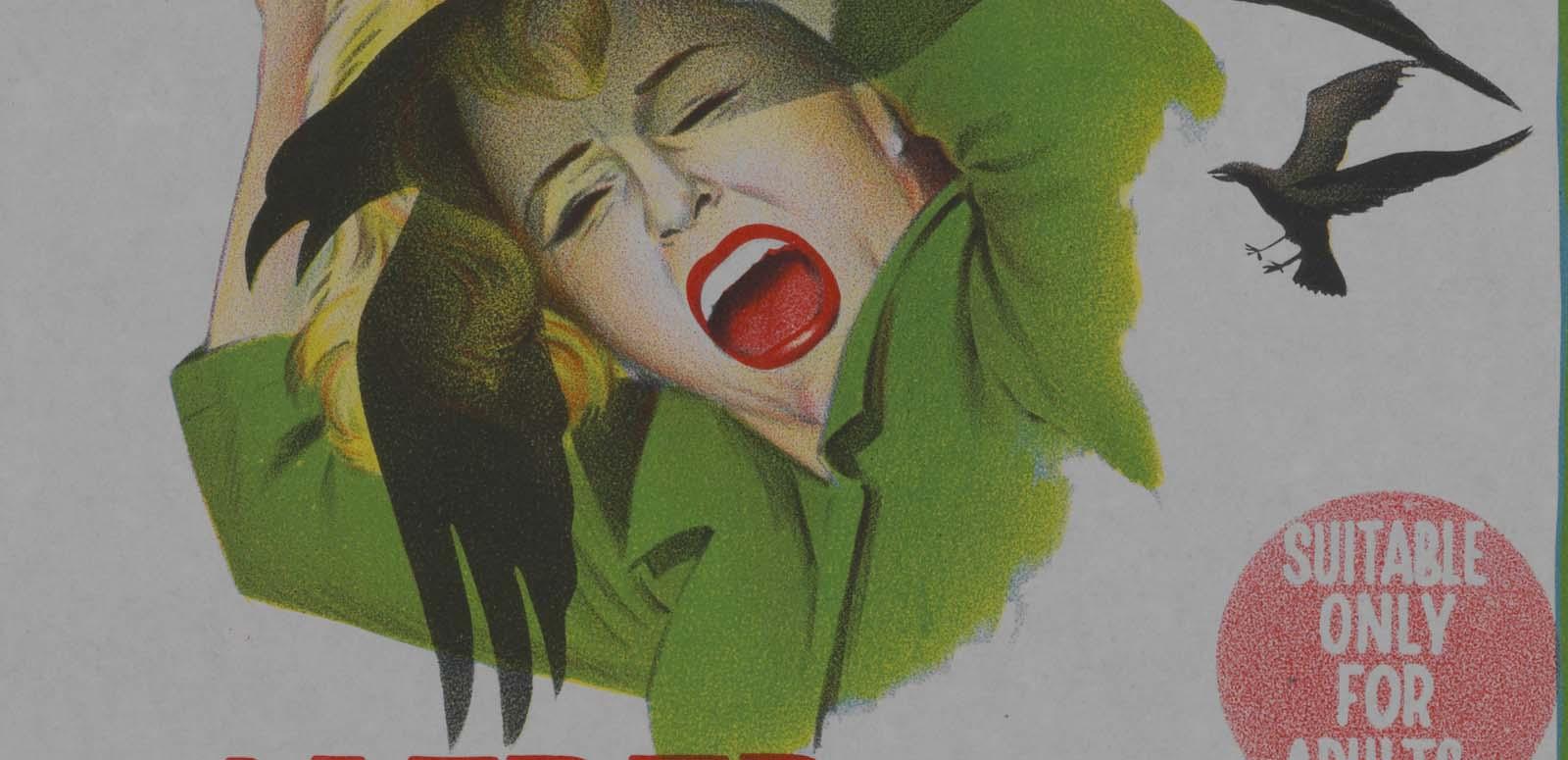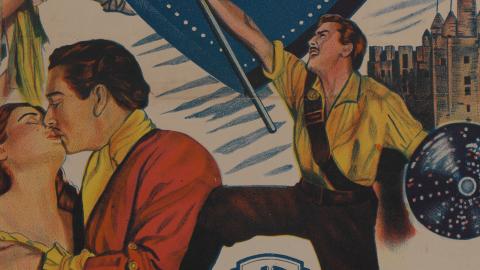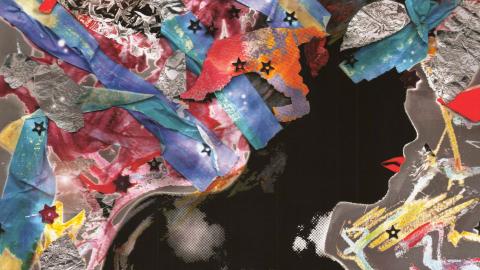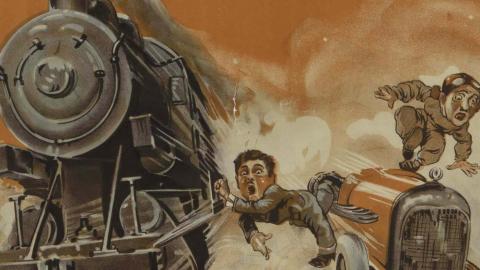

Framed by Fame: Poster Notes
Framed by Fame: Australian Daybill Posters
These daybill posters from the 1950s and 60s represent the diverse talents and achievements of Australian creatives overseas, and their contribution to the international motion picture industry. View the posters in the Framed by Fame curated collection.
Limelight (Charlie Chaplin, USA, 1952)
Starring Marjorie Bennett (1896–1982) b. York, WA
Marjorie Bennett commenced her career in Hollywood, like so many actors of her generation, as a silent film star. Touted as a potential Oscar nominee for her role as Chaplin’s landlady in Limelight, her hopes were dashed when pressure from the American Legion affected the film’s opening during the McCarthy era. Chaplin’s alleged Communist connections meant that Limelight did not screen in Los Angeles for another 20 years. This was Bennett’s second collaboration with Chaplin, after Monsieur Verdoux (1947).
Botany Bay (John Farrow, USA, 1953)
Directed by John Farrow (1904–1963) b. Sydney, NSW
John Farrow directed an impressive 50 films; however, Botany Bay was only the second (besides The Sea Chase, 1955) to have a connection to his native Australia. Included in the film’s cast were two kangaroos and four koalas flown to America for filming. Farrow received an Academy Award for co-writing Best Picture winner Around the World in 80 Days (1956) and was nominated for directing Wake Island (1942). As one of the few high-profile Australians working in Hollywood in the 1940s, Farrow accepted the Oscar awarded to the Cinesound Review newsreel Kokoda Front Line! (1942) on behalf of Ken G Hall and Damien Parer.
Hondo (John Farrow, USA, 1953)
Starring Michael Pate (1920–2008) b. Drummoyne, NSW
Michael Pate starred as Vittorio, a Chiricahua Apache chief, in the 3D Western film Hondo. Despite having no Native American ancestry, Pate was offered the role by producer John Wayne after it was turned down by Gilbert Roland and Pedro Armendáriz, two Mexican American actors. Pate gained a reputation in Hollywood for playing Native American roles – he later recalled that 25 of his 350 film roles were Native American. Prior to his move abroad, Pate worked with Charles Chauvel in Forty Thousand Horsemen (1940) and Chips Rafferty in Horsemen and Bitter Springs (1950).
The Master of Ballantrae (William Keighley, UK, 1953)
Starring Errol Flynn (1909–1959) b. Battery Point, Tas
Tasmanian-born actor Errol Flynn starred as Jamie Durie in his archetypal role as a romantic swashbuckler. This was Flynn’s last film with Warner Bros, the end of a nearly 20-year association which yielded 35 films. Flynn came to acting by accident, reputedly making his film debut in Charles Chauvel’s In the Wake of the Bounty (1933) after actor John Warwick brought him to a casting session. Flynn achieved worldwide fame during Hollywood’s golden age but gained a shocking reputation for a life clouded by scandal, drink, sex and drugs.
Passage Home (Roy Ward Baker, UK, 1955)
Starring Diane Cilento (1932–2011) b. Mooloolaba, Qld
In her leading role debut, 21-year-old Diane Cilento stood out as the sole female actor among a cast of 30 men. She played British governess Ruth Elton, the only woman onboard a cargo ship. Working alongside fellow Australian Peter Finch for the first time (they later acted together in I Thank a Fool, 1962), Cilento bravely performed her own stunts, rolling around on a deck in filthy water. Her performance was met with rave reviews. Evening Standard film critic Thomas Wiseman dubbed her the Audrey Hepburn of 1956. Pinewood Studios’ production chief Earl St John gushed, ‘She combines the sex appeal of a Lollobrigida with the cool sensitivity of a Grace Kelly. Within a year she will be one of the biggest stars in Britain.’
To Catch a Thief (Alfred Hitchcock, USA, 1955)
Co-written by Alec Coppel (1907–1972) b. Melbourne, Vic
While uncredited, screenwriter, novelist and playwright Alec Coppel assisted with writing Hitchcock’s romantic thriller To Catch a Thief. Paid US$1,250 for a week’s worth of work to assist with rewrites, dialogue, and inserts, it was the beginning of a collaboration between the two creatives. In 1956, Coppel worked with the Master of Suspense to write Vertigo (1958). His draft of the script was rejected by Hitchcock in favour of Samuel A Taylor’s later version. However, Coppel protested to the Screen Writers Guild, which determined that both writers were entitled to a credit. He was the first Australian to be recognised by the American Academy for writing, with an Oscar nomination for Best Writing (Motion Picture Story) for The Captain’s Paradise (1953).
Alexander the Great (Robert Rossen, USA, 1956)
Cinematography by Robert Krasker (1913–1981) b. Perth, WA
Alexander the Great was the first of many epic films delivered by acclaimed cinematographer Robert (Bob) Krasker. Known for favouring realism over glamour, as well as his high-contrast images and unconventional compositions, this dramatised biography is synonymous with his later work on spectacles like El Cid (1961) and The Fall of the Roman Empire (1964). The epic genre was a far cry from Krasker’s earlier, and arguably most significant, work. For the iconic film noir masterpiece, The Third Man (1949), he was awarded an Oscar for Best Cinematography (Black-and-White), the first Australian to receive this distinction.
The Long Arm (Charles Frend, UK, 1956)
Starring Dorothy Alison (1925–1992) b. Broken Hill, NSW
Broken Hill native Dorothy Alison starred opposite Jack Hawkins in this crime film about Scotland Yard detectives investigating a series of burglaries. After a promising start in London with a BAFTA nomination for Most Promising Newcomer in Mandy (1952), Alison struggled to find work and considered returning to Australia. Her persistence paid off and she starred in over 70 films and television series. Alison was often typecast as the wholesome, selfless woman, but this was something she later said she accepted and enjoyed. Her name features prominently on this cool-hued poster, possibly to appeal to Australian audiences.
Some Like it Hot (Billy Wilder, US, 1959)
Costume design by Orry-Kelly (1897–1964) b. Kiama, NSW
Costume designer Orry-Kelly won his third Academy Award for Best Costume Design for Some Like It Hot (1959). However, as described in his memoir Women I’ve Undressed, working with lead actress Marilyn Monroe wasn’t always easy. She was frequently late to fittings, difficult to appease and easily offended. Centre stage in this poster, Monroe is wearing a black chiffon nightgown, a controversial costume choice for 1959. To avoid censorship, Orry-Kelly added conveniently positioned lace embellishments and a black chiffon and feather robe.
On the Beach (Stanley Kramer, USA, 1959)
Starring John Meillon (1934–1989) b. Mosman, NSW
Starring alongside some of the biggest names in Hollywood, 24-year-old John Meillon made his film debut as Ralph Swain in this post-apocalyptic drama. Filming took place around Victoria with the Royal Australian Navy providing support and access to the aircraft carrier HMAS Melbourne and submarine HMS Andrew. His second film role, in The Sundowners (1960), took Meillon to London. While his career flourished abroad, he returned to Australia in 1964. Two decades later he was cast in arguably his most recognisable role as Walter ‘Wally’ Reilly, Mick Dundee’s sidekick in Crocodile Dundee (1986).
No Love for Johnnie (Ralph Thomas, UK, 1961)
Starring Peter Finch (1916–1977) b. London, UK
Although born in London, multiple award-winning actor Peter Finch spent his formative years in Sydney. He was discovered in 1948 by Sir Laurence Olivier while on tour in Australia. Olivier offered Finch a theatre contract in London after seeing his performance in Le Malade Imaginaire (The Imaginary Invalid). In No Love for Johnnie, Finch portrayed a cynical and disillusioned Labour MP who sought escape in a relationship with a younger woman. To prepare for the role, Finch researched British law and visited the UK Houses of Parliament. His performance was widely admired and won him the BAFTA Award for Best British Actor and the Silver Bear for Best Actor at the 11th Berlin International Film Festival.
The Innocents (Jack Clayton, UK, 1961)
Starring Clytie Jessop (1929–2017) b. Sydney, NSW
Clytie Jessop made her film debut as the ghost of Miss Jessel, while starring alongside Deborah Kerr, a six-time Academy Award nominee. While Jessop’s role was brief, the haunting image of her as the dead governess standing in the bulrushes left a lasting impression on viewers. Her ghostly face is highlighted in the centre of the poster. Jessop carved a niche in horror, starring in two subsequent films directed by acclaimed cinematographer and director Freddie Francis. In 1986, Jessop wrote, directed and produced the Australian film Emma’s War (1987).
The Birds (Alfred Hitchcock, USA, 1963)
Starring Rod Taylor (1930–2015) b. Lidcombe, NSW
In one of his most famous roles, Rod Taylor starred alongside Tippi Hedren in Hitchcock’s thriller, The Birds. After winning an airline ticket to Los Angeles in a 1954 radio talent competition, Taylor’s career steadily progressed. His big television break came with the series Hong Kong, after which he was approached by Hitchcock to play the dashing hero Mitch Brenner. The Birds was revolutionary for its techniques. The film had no musical score; instead, Hitchcock adopted a new electronic sound system to unnervingly emulate the sound of flapping wings. Additionally, much to the chagrin of ornithophobes, Hitchcock insisted on using live birds, rather than props, for close-ups.
Do Not Disturb (Ralph Levy, USA, 1965)
Starring Rod Taylor (1930–2015) b. Lidcombe, NSW
Looking through the keyhole, the viewer sees Rod Taylor, who starred in this romantic comedy alongside Doris Day, one of the biggest film stars of the 1950s and 1960s. Filming started in January 1965 on Rod Taylor’s 35th birthday. The trailer boasted of ‘a wardrobe costing a king’s ransom’ and was reported to total US$50,000. Despite being set in London and Paris, the cast and crew never left the Hollywood studio backlot. There were constant rewrites during shooting. Lucille Ball’s long-time writer Bob Carroll, who worked on the film, quipped that the title should have been Do Not Distribute. This was the first film Taylor shared the screen with Day; they reunited a year later for The Glass Bottom Boat (1966).
The National Film and Sound Archive of Australia acknowledges Australia’s Aboriginal and Torres Strait Islander peoples as the Traditional Custodians of the land on which we work and live and gives respect to their Elders both past and present.


